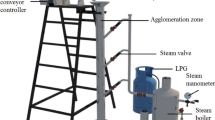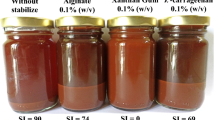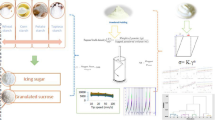Abstract
Characterization of flow properties represents a crucial step in the production of powdered composite mixtures. Mixing of cocoa powders with different sugars is the first step in the production of this type of beverages, which leads to a change in the mixtures flow properties. The objective of this work was firstly to determine the physical properties of non-agglomerated powdered cocoa and sugar mixtures and, after that, to determine which physical properties of cocoa powders are influenced by sugar addition and in what way they are influenced by sugars. Mixtures were formulated by two cocoa powders containing different amounts of fat and 11 different kinds of sugar or sweetener. A significant change was found in the median diameter, poured bulk density, compression and decompression force of the mixtures compared to the sole components’ physical properties. All the mixtures display a decreasing compaction coefficient with increase of flow speed, which indicates that these powder mixtures flow more freely at higher transport speeds. An increase of cake height ratio was detected in all the mixtures, indicating that all the mixtures were susceptible to caking and that they formed a strong cake. Insolubility of the mixtures was influenced significantly by the median diameter of the sugar particles added to the mixture. Addition of sugars and sweeteners to the cocoa powder reduced the red and yellow colour components, but the type of sugar or sweetener did not produce a considerable difference in the colour of the cocoa drink mixtures.







Similar content being viewed by others
References
Abu-hardan, M., & Hill, S. E. (2010). Handling properties of cereal materials in the presence of moisture and oil. Powder Technology, 198, 16–24.
Belščak-Cvitanović, A., Benković, M., Komes, D., Bauman, I., Horžić, D., Dujmić, F., & Matijašec, M. (2010). Physical properties and bioactive constituents of powdered mixtures and drinks prepared with cocoa and various sweeteners. Journal of Agricultural and Food Chemistry, 58(12), 7187–7195.
De Muijnck, L. (2005). Cocoa. In C. Onwulata (Ed.), Encapsulated and powdered foods (pp. 451–473). Florida: CRC.
Eduardo, M. F., & Lannes, S. C. S. (2007). Use of texture analysis to determine compaction force of powders. Journal of Food Engineering, 80, 568–572.
Fitzpatrick, J. J. (2005). Food powder flowability. In C. Onwulata (Ed.), Encapsulated and powdered foods (pp. 247–258). Florida: CRC.
Fitzpatrick, J. J. (2007). Effect of composition and storage conditions on the flowability of dairy powders. International Dairy Journal, 17, 383–392.
Galet, L., Vu, T. O., Oulahna, D., & Fages, J. (2004). The wetting behaviour and dispersion rate of cocoa powder in water. Food and Bioproducts Processing, 82(C4), 298–303.
Gerhards, C., Kael, C., & Schubert, H. (2004). Measurement of attrition of agglomerated cocoa beverage powders: a comparison of Friabilator and vibration tests. Journal of Food Engineering, 65, 101–108.
Ghosal, S., Indira, T. N., & Bhattacharya, S. (2010). Agglomeration of a novel food powder: effect of maltodextrin and gum Arabic dispersions on flow behaviour and compacted mass. Journal of Food Engineering, 96, 222–228.
Ilangantileke, S. G., Wahyudi, T., & Bailon, G. (1991). Assessment methodology to predict quality of cocoa beans for export. Journal of Food Quality, 14, 481–496.
Jain, R. K., & Bal, S. (1997). Properties of pearl millet. Journal of Agricultural Engineering Research, 66, 85–91.
Judd, D. B., & Wyszecki, G. (1967). Colour in business science and industry. New York: Wiley.
Kowalska, J., & Lenart, A. (2005). The influence of ingredients distribution on properties in agglomerated cocoa products. Journal of Food Engineering, 68, 155–161.
Minifie, B. W. (1989). Chocolate cocoa and confectionery: Science and technology. New York: Chapman & Hall.
Omobuwajo, T. O., Busari, O. T., & Osemwegie, A. A. (2000). Thermal agglomeration of chocolate drink powder. Journal of Food Engineering, 46, 73–81.
Özkan, N., Walisinghe, N., & Chen, X. D. (2002). Characterization of stickiness and cake formation in whole and skim milk powders. Journal of Food Engineering, 55, 293–303.
Rennie, P. R., Chen, X. D., Hargreaves, C., & Mackereth, A. R. (1999). A study of the cohesion of dairy powders. Journal of Food Engineering, 39, 277–284.
Shittu, T. A., & Lawal, M. O. (2007). Factors affecting instant properties of powdered cocoa beverages. Food Chemistry, 100, 91–98.
Straatsma, J., Van Houwelingen, G., Steenbergen, A. E., & De Jong, P. (1999). Spray drying of food products: 2. Prediction of insolubility index. Journal of Food Engineering, 42, 73–77.
Telis, V. R. N., & Martinez-Navarrete, N. (2010). Application of compression test in analysis of mechanical and colour changes in grapefruit juice powder as related to glass transition and water activity. LWT- Food Science and Technology, 43, 744–751.
Teunou, E., Fitzpatrick, J. J., & Synnott, E. C. (1999). Characterization of food powder flowability. Journal of Food Engineering, 39, 31–37.
Vissotto, F. Z., Jorge, L. C., Makita, G. T., Rodrigues, M. I., & Menegalli, F. C. (2010). Influence of the process parameters and sugar granulometry on cocoa beverage powder steam agglomeration. Journal of Food Engineering, 91, 283–291.
Vu, T. O., Galet, L., Fages, J., & Oulahna, D. (2003). Improving the dispersion kinetics of cocoa powder by size enlargement. Powder Technology, 130, 400–406.
Yanes, M., Duran, L., & Costell, E. (2002). Rheological and optical properties of commercial chocolate milk beverages. Journal of Food Engineering, 54, 229–234.
Acknowledgements
The authors would like to thank the food industry “Zvečevo” for supplying the cocoa powder used in this study. This work was supported by the Ministry of Science, Education and Sports, Republic of Croatia, Projects 058-0581846-2810 and 058-0000000-3470.
Author information
Authors and Affiliations
Corresponding author
Rights and permissions
About this article
Cite this article
Benković, M., Belščak-Cvitanović, A., Komes, D. et al. Physical Properties of Non-Agglomerated Cocoa Drink Powder Mixtures Containing Various Types of Sugar and Sweetener. Food Bioprocess Technol 6, 1044–1058 (2013). https://doi.org/10.1007/s11947-011-0742-0
Received:
Accepted:
Published:
Issue Date:
DOI: https://doi.org/10.1007/s11947-011-0742-0




